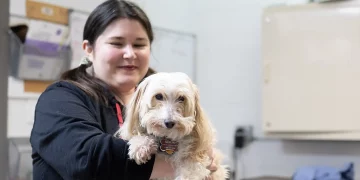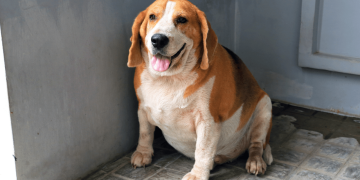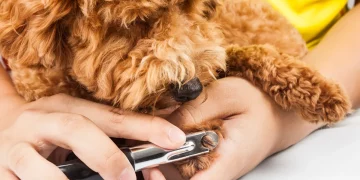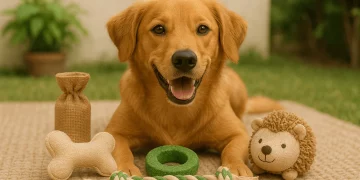As responsible pet owners, it’s our job to ensure that our pets live a long and healthy life. One of the most significant aspects of maintaining their overall well-being is managing their weight. Just like humans, pets can be prone to obesity, which can lead to serious health issues such as diabetes, arthritis, heart disease, and a decreased quality of life.
Recognizing if your pet is overweight and taking steps to manage their weight through diet is essential for their long-term health. This article will provide you with the tools to assess whether your pet is overweight, offer advice on how to adjust their diet, and give you tips to help your furry friend shed those extra pounds safely and effectively.
1. How to Determine If Your Pet Is Overweight
Before making changes to your pet’s diet, it’s crucial to assess whether they are truly overweight. Many pet owners may not realize that their pets have put on excess weight, especially when their pets’ coat can sometimes mask weight gain. Here are some easy ways to assess if your pet is overweight:
1.1. Perform a Body Condition Score (BCS)
A Body Condition Score (BCS) is a simple way to determine whether your pet is overweight. The BCS scale typically ranges from 1 to 9, with 1 being severely underweight and 9 being obese. Ideally, your pet should fall between 4 and 5 on this scale, indicating that they are in good physical condition.
- 1-3 (Underweight to Ideal): Your pet’s ribs are easily visible, and there is minimal fat covering. The waist is easily noticeable, and there is an obvious abdominal tuck.
- 4-5 (Healthy Weight): Your pet has a visible waist when viewed from above, and you can feel their ribs easily but not see them. There is a slight abdominal tuck when viewed from the side.
- 6-9 (Overweight to Obese): You may not be able to feel your pet’s ribs, and their waistline is less defined or absent. The abdomen may sag, and there may be noticeable fat deposits around the tail, neck, and limbs.
Regularly assessing your pet’s BCS will help you monitor any weight changes over time.
1.2. Check for Visible Signs of Overweight
Some physical signs to watch for include:
- Rounder abdomen: A noticeable belly that hangs lower or a lack of an abdominal tuck.
- Difficulty in movement: Your pet may have difficulty jumping or moving around comfortably, especially in older animals.
- Breathing issues: Overweight pets may breathe harder than usual, especially during exercise.
- Fat deposits: Watch for fat deposits in areas like the neck, tail base, and limbs. These are signs that your pet is carrying extra weight.
1.3. Compare to Breed Standards
Different breeds have different ideal body types, so it’s helpful to know the general weight range for your pet’s breed. Ask your veterinarian about your pet’s ideal weight or use online resources specific to your pet’s breed to compare. Keep in mind that weight alone doesn’t define health; the distribution of that weight and the overall BCS is more important.
2. Why Weight Management Is Crucial for Your Pet’s Health
Carrying extra weight can put a significant strain on your pet’s body. Here are some health risks associated with obesity:
2.1. Joint Problems
Excess weight increases the pressure on your pet’s joints, which can lead to joint pain, arthritis, and mobility issues. This is particularly concerning for larger breed dogs, who are already more prone to joint problems like hip dysplasia.
2.2. Heart Disease and Respiratory Issues
Obesity can lead to cardiovascular issues, as the heart has to work harder to pump blood throughout the body. Additionally, excess weight can cause respiratory problems and make it more difficult for your pet to breathe, particularly in hot weather or during exercise.
2.3. Diabetes
Obesity is one of the leading risk factors for diabetes in pets, particularly in cats and dogs. Overweight pets are less able to regulate their blood sugar levels, leading to insulin resistance, a condition that can lead to diabetes.
2.4. Shortened Lifespan
Obese pets often have a shorter lifespan compared to those with a healthy weight. Extra weight can lead to a variety of health problems that compromise their immune system, decrease energy levels, and ultimately affect their longevity.

3. Tips for Managing Your Pet’s Weight Through Diet
The first and most effective way to manage your pet’s weight is by adjusting their diet. Here are some practical tips to help your pet reach and maintain a healthy weight:
3.1. Measure Their Food
One of the easiest ways to control your pet’s weight is to monitor how much food they are eating. Use a measuring cup or scale to ensure that you are giving the appropriate portion size based on your pet’s age, breed, activity level, and current weight. Overfeeding, even if the food is healthy, can lead to weight gain.
3.2. Choose a High-Quality, Nutrient-Dense Food
High-quality pet food with a balanced nutrient profile is essential for weight management. Look for foods with high protein content and healthy fats that will help your pet feel full and satisfied while providing the necessary energy. Avoid fillers like corn, soy, and by-products, which offer minimal nutritional value. Ask your veterinarian for recommendations on specific brands or formulations for weight management.
3.3. Avoid Table Scraps and Excess Treats
It can be tempting to share your food with your pet, but table scraps are often high in calories and not formulated for pet health. Additionally, many treats can contribute to weight gain if given in excess. Use low-calorie treats and measure them as part of your pet’s daily calorie intake. You can also consider using treats as part of your pet’s training or enrichment activities to keep them engaged and active.
3.4. Use Special Weight Loss Formulas
There are specific pet food formulas designed to help with weight loss. These foods typically have fewer calories, more fiber, and higher protein to promote fat loss while preserving muscle mass. Consult your veterinarian to find out if these formulas are suitable for your pet and ensure that they are receiving balanced nutrition.
3.5. Control Feeding Times
Rather than leaving food out all day, establish set meal times for your pet. Typically, pets should be fed twice a day—once in the morning and once in the evening. Limiting food access to specific times can prevent overeating and help regulate their calorie intake.
3.6. Offer Fresh, Clean Water
Sometimes, pets eat due to boredom or thirst, not hunger. Ensure your pet always has access to fresh water, as proper hydration is crucial for overall health. Drinking water can also help them feel fuller and curb their appetite.
4. Exercise and Lifestyle Changes for Weight Management
Diet plays a significant role in weight management, but exercise is equally important in helping your pet burn calories and maintain a healthy weight. Here are some exercise tips:
4.1. Regular Exercise
Incorporating daily walks, play sessions, or exercise routines into your pet’s life is key to burning off excess calories. Dogs can benefit from daily walks, fetch games, or runs in the yard, while cats can enjoy playtime with toys that simulate hunting, such as laser pointers or interactive feeders.
4.2. Gradual Weight Loss
If your pet is significantly overweight, it’s important to approach weight loss gradually. Rapid weight loss can lead to health complications like liver disease. Aim for a weight loss of no more than 1-2% of your pet’s body weight per week, and monitor their progress.
4.3. Mental Stimulation
Mental stimulation is just as important as physical exercise. Providing your pet with puzzle feeders, new toys, or training activities can help keep them engaged and reduce boredom, which can sometimes lead to overeating. Cats, in particular, benefit from activities that mimic hunting behaviors, such as food-dispensing toys or interactive laser play.
4.4. Reduce Stress
Stress can lead to overeating in some pets, especially if they have anxiety or are prone to emotional eating. Ensure that your pet’s environment is calm and that they have a safe space to relax. Try to maintain a consistent routine for feeding, exercise, and relaxation.
5. Monitoring and Long-Term Maintenance
Once your pet reaches a healthy weight, it’s important to maintain that weight to avoid future health issues. Regularly weigh your pet and assess their BCS to ensure they are staying on track. Adjust their diet and exercise routine as needed to maintain balance, especially as they age.
6. Conclusion
Managing your pet’s weight is essential for their overall health and longevity. By recognizing the signs of overweight, adjusting their diet, incorporating exercise, and following the tips outlined in this article, you can help your pet reach and maintain a healthy weight. Always consult your veterinarian for personalized advice on weight management and ensure that your pet is receiving the right nutrition for their specific needs.
Maintaining a healthy weight not only improves your pet’s physical health but also enhances their quality of life, allowing them to enjoy their favorite activities for years to come.























































